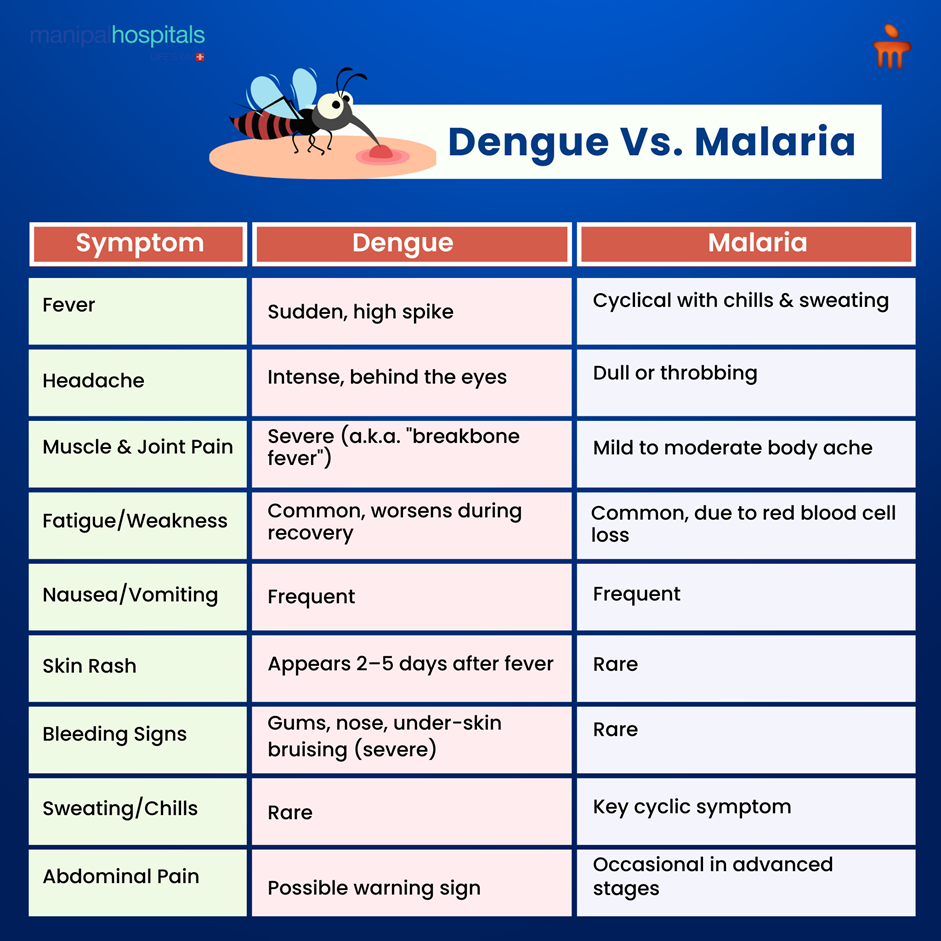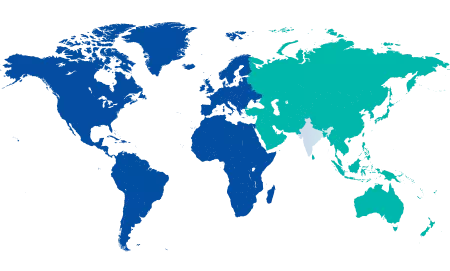
With the monsoon season comes the risk of mosquito-borne illnesses like dengue and malaria, especially in tropical regions like India. Stagnant water and humid conditions are ideal for the breeding of mosquitoes, which can cause these diseases. Hence, there is a seasonal spike in infections.
In this blog, we discuss the symptoms, differences, and complications of both diseases. We also cover diagnostic methods, available treatments, and effective ways to prevent mosquito bites and breeding. With timely awareness and practical steps, families can stay protected during high-risk months. Knowing when to seek medical care is key to avoiding serious health outcomes linked to these preventable infections.
Synopsis
What is Dengue?
Dengue is a very common viral infection in the monsoon. This mosquito-borne illness occurs when an infected Aedes aegypti mosquitoes bite. These mosquitoes, most active during early morning and late afternoon, can transmit any of the 4 different types of viruses that cause dengue.
Key facts about dengue fever:
-
It spreads through mosquito bites, not from person to person.
-
A second infection with a different serotype increases the risk of severe dengue.
-
The virus affects blood vessels, which may lead to bleeding, low platelet counts, and fluid leakage.
-
There is no specific antiviral treatment; management focuses on supportive care and monitoring warning signs.
What is Malaria?
Malaria is a life-threatening disease that is more common in tropical and subtropical regions. Malaria infection is caused by Plasmodium parasites, which can be transmitted through the bite of infected Anopheles mosquitoes.
Key facts about malaria disease:
-
5 types of Plasmodium species infect humans, with P. falciparum being the most severe.
-
Symptoms appear 10 to 15 days after the bite.
-
The parasite targets red blood cells, causing anaemia and organ complications in severe cases.
-
Malaria can recur if not treated fully, especially with P. vivax.
-
Prompt diagnosis and malaria treatment are essential for recovery.

Dengue and Malaria Symptoms to Watch For
Beyond common fever and fatigue, dengue and malaria can cause more serious complications if untreated.
Common Dengue and Malaria Symptoms:
|
Symptom. |
Dengue. |
Malaria. |
|
Fever. |
A sudden high fever may spike rapidly. |
Recurring fever with chills and sweating. |
|
Headache. |
Intense, often behind the eyes. |
General headache, dull or throbbing. |
|
Muscle and joint pain. |
Severe fever. |
Mild to moderate, with body ache. |
|
Fatigue/Weakness. |
Common, worsens during recovery. |
Common, due to red blood cell loss. |
|
Nausea and vomiting. |
Frequent. |
Frequent. |
|
Skin rash. |
Appears 2–5 days after fever begins. |
Not usually |
|
Bleeding signs. |
Gums, nosebleeds, under-skin bruising (severe cases) |
Rare. |
|
Sweating and chills. |
Rare. |
Defining symptoms and coming cyclically. |
|
Abdominal pain. |
Warning signs of severe dengue. |
Occasionally present in advanced cases. |
Preventing Dengue and Malaria During Monsoon
Monsoon creates ideal breeding conditions for mosquitoes due to waterlogging, poor drainage, and high humidity in the air. Preventing dengue and malaria requires both personal protection and environmental control. Early action during the rainy season can significantly reduce the risk of infection.
Eliminate Mosquito Breeding Sites
This is the most important. Mosquitoes that spread dengue and malaria breed in stagnant water. Simple steps taken at home and in the community can limit breeding:
-
Empty and scrub water containers every two days (flower pots, birdbaths, buckets).
-
Cover overhead tanks and cisterns with tightly fitted lids.
-
Keep gutters and drains clear to prevent clogging.
-
Avoid storing water in open containers; use only covered vessels.
Municipal efforts, such as fogging and larvicide application, are more effective when supported by residents keeping their surroundings clean.
Personal Protection Measures
Reducing mosquito bites is the biggest step in staying safe. It’s most effective during peak mosquito activity times, which are early morning and evening for Aedes (dengue), dusk to dawn for Anopheles (malaria).
Protective steps include:
-
Wear long-sleeved clothing, trousers, and socks when outdoors.
-
Applying mosquito repellent on exposed skin, DEET-based products are most effective.
-
Using mosquito nets, especially for children and the elderly.
-
Installing mesh screens on windows and doors to block entry.
Community Involvement
Preventing the spread of the disease is also a community act, as the action of each person counts. Participate in public health campaigns and community cooperation. Here are some ways:
-
Participate in local clean-up drives and awareness events.
-
Report areas with heavy mosquito breeding to civic authorities.
-
Schools, workplaces, and housing societies should conduct regular inspections and sanitation.
When to Seek Medical Help
During monsoon, any persistent fever should not be ignored. Instead, identify symptoms of dengue and malaria and take proper measures as and when required. Seek medical care if you notice:
-
High fever lasting more than two days.
-
Severe headache, joint pain, or skin rash.
-
Signs of dehydration or persistent vomiting.
-
Bleeding from the gums, nose, or under the skin.
-
Confusion, drowsiness, or difficulty breathing.
Conclusion
The rise in dengue and malaria cases during monsoon stresses the need for awareness, prevention, and timely care. Simple steps like avoiding stagnant water, using mosquito protection, and recognising early symptoms can go a long way in safeguarding your family’s health.
If you or a loved one experiences warning signs, don’t wait. Manipal Hospital Jayanagar offers expert care and comprehensive malaria treatment in Bangalore, supported by accurate diagnostics and experienced specialists. Early intervention can make all the difference.
Book your consultation with our Internal Medicine doctor today for peace of mind this monsoon.
FAQ's
Both dengue and malaria start with high fever and body aches. Dengue usually causes joint pain, skin rash, and bleeding in severe cases. But malaria brings chills, sweating, and anaemia-like symptoms. Only a blood test can confirm the diagnosis, so it’s important to see a general physician early.
Yes, there are 4 types of dengue viruses, and getting one doesn’t protect you from the others. Malaria can also come back if not fully treated, especially with certain parasite types like Plasmodium vivax.
For dengue, symptoms usually appear 4–10 days after a bite. In malaria, symptoms can start anywhere from 7 to 30 days after exposure, depending on the parasite. If you feel unwell during or after the monsoon, don’t delay getting tested.
Use mosquito repellents, wear full-sleeved clothing, and keep doors and windows screened. Empty standing water from containers, trays, and coolers regularly to stop mosquito breeding near your home.
Manipal Hospitals provides expert malaria treatment in Bangalore, including early diagnosis, targeted medications, and hospital care for severe cases. If you suspect malaria, visit the nearest Manipal facility for timely medical support.





















 6 Min Read
6 Min Read






.png)












